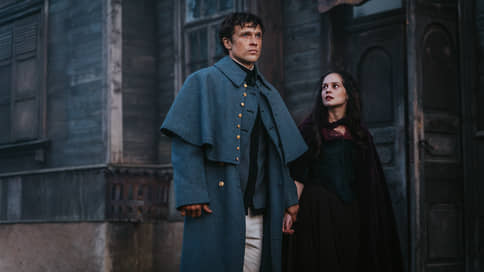Ni Po ni sho – Newspaper Kommersant No. 174 (7375) of 09/21/2022
[ad_1]

Christopher Hutton’s horror film “Crow’s Hollow” is released, the main character of which is Edgar Allan Poe. The authors propose to believe that all the fantastic motives in his work were the result of a collision with the supernatural experienced in his youth. Despite the courage in handling the biography of the classic, the film is let down by the frank secondary plot and visuals, believes Yulia Shagelman.
Crow’s Hollow begins like a classic scary tale: with a girl (Elsa Clavina) walking through the woods with a basket of cakes. Unlike Little Red Riding Hood, who fearlessly went to visit her grandmother, she is alarmed from the very beginning and shudders at every rustle, and especially from the sight of a raven hovering above her in the pale autumn sky. And not in vain: soon someone is already chasing the girl, forcing her to rush home, where an unknown force first throws her up to the ceiling, and then sprays her on a lot of black birds flying out through the chimney. In a word, we are immediately made to understand that in the town of Voronya Hollow, as befits a place with such an unpleasant name, something gloomy, dangerous and unnatural is going on.
The second proof of this is a bloody corpse crucified on a makeshift rack in a field near the town. He is bumped into by five West Point Military Academy cadets who are returning from an exercise. One of them, a young man with romantic curls (William Moseley), whom his comrades call by his surname Po, is not only disgusted by the terrible find, but also some kind of morbid curiosity. He approaches the tortured man, discovers that he is still alive, and manages to hear his last words that a certain “Raven” tortured him. At this, the unfortunate man expires, but Poe insists that he must be taken to the nearest settlement for a Christian burial. So the cadets find themselves in Crow’s Hollow, and Poe takes the first step on the path that will turn him from a brave future officer into an alcoholic and morphine addict, obsessed with morbid fantasies. And also the founder of the detective genre, the author of scary stories and the genius of late romanticism.
He himself, of course, does not yet suspect this, but Crow’s Hollow is full of rather superficial references to Poe’s future works. For example, a black servant (Oberon Ka Agipong) at a local hotel is called Asher, the beautiful daughter (Melanie Zanetti) of the owner of this establishment talks about her either dead or missing sister Lenore, and at some point into the hands of our hero, to his terrifyingly, the real, yet beating heart of a dead man is caught – not exactly like in the story “The Tell-Tale Heart”, but close enough to understand where Christopher Hutton and his co-writer Chuck Reeves got this image.
Of course, the poor fellow found in the field is not the first and far from the last victim. While Edgar’s colleagues are dying one by one, he takes on the investigation and behaves like a real detective. At the same time, the locals, who met strangers with poorly concealed hostility, now and then commemorate the sinister Raven, who seems to be worshipped. At first, Edgar does not believe in any Raven and is looking for a rational explanation for the events taking place. However, their strangeness and cruelty begin to affect him, he is increasingly applied to a cocktail of whiskey and opium tincture, and gradually loses touch with reality more and more.
The classic of American literature has already become a movie hero: in the critically acclaimed film The Crow (2011), to put it mildly, he investigated a series of murders based on his own works before his death. However, director Hutton apparently focused not on this forgotten thriller, but on the film adaptation of another classic – Tim Burton’s Sleepy Hollow, based on the story of Washington Irving. From there, in his picture, both the gloomy autumn colors and the images of pale maidens, who are in close relationship with otherworldly forces. In places, Hutton, despite the modesty of the budget and the absence of major stars, even almost manages to achieve the desired mystical-Gothic atmosphere. But will his film be remembered as much as a role model? The raven from Edgar Allan Poe’s poem would answer this question quite unambiguously.
[ad_2]
Source link






